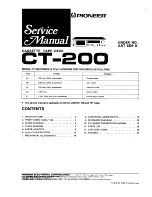
Aufzeichnung:
Vierspur oder wahlweise Zweispur
(durch austauschbaren Tonkopfträger)
Mono- und Stereo-Aufnahme und
- Wiedergabe
Bandgeschwindigkeiten:
1 9 cm/s
9,5 cm/s
4,7 cm/s
2,1
cm/s
Frequenzbereich 19 cm/s:
20-20 000 Hz
Frequenzbereich 9,5 cm/s:
20-15 OCO Hz
Frequenzbereich 4,7 cm/s:
20-9000 Hz
Tonhöhenschwankungen 19 cm/s:
± 0,04 %
Tonhöhenschwankungen 9,5 cm/s:
± 0,10 %
Tonhöhenschwankungen 4,7 cm/s:
0,20 %
Ruhegeräuschspannungsabstand 19
56 dB/4 Sp. >
58 dB/2 Sp.)
Ruhegeräuschspannungsabstand 9,5
55 dB/4 Sp. (› 57 dB/2 Sp.)
Ruhegeräuschspannungsabstand 4,7
52 dB/4 Sp. ('; 56 dB/2 Sp.)
Löschdämpfung:
1 9 cm/s: - 72 dB, 1000 Hz
Generatorfrequenz:
1 00 kHz ± 10%
Übersprechdämpfung:
> 60 dB Mono / > 45 dB Stereo
Eingang: Mikrofon
0,12 mV-max. 70 mV
Eingang: Radio
1,2 mV - max. 110 rrv
Eingang: Phono I
> 40 mV - max. 2,8 V
Eingang: Phono II
-° 200 mV - max. 18 V
Ausgänge:
700 mV an 15 kOhm
Lautsprecherausgang:
6,4 V an 4 Ohm - 10 Watt
Quellwiderstand 0,1 Ohm
Monitor:
2
500 mV an 15 kOhm
2.71 Daten des Verstärkers
Übertragungsbereich:
20-30 000 Hz
Alle Daten werden entsprechend den durch
die deutschen Normen (DIN) festgelegten
Meßvorschriften für Magnettongeräe ange-geben.
Type of recording:
Four-track or optionally two-track
(with interchangeable sound-head
assemblies) mono and stereo
recording and Playback
Tape speeds:
7 112, 3 3/4, 1 7/8, 15/16 ips
Frequency range at 7 t i2 ips:
20-20.000 Hz
Frequency range at 3 3/4 ips:
20-15,000 Hz
Frequency range at 1 7/8 ips:
20-9,000 Hz
Wow and flutter at 7 1/2 ips:
+- 0.04
°7o
Wow and flutter at 3 3/4 ips:
0.10%
Wow and flutter at 1 7/8 ips:
± 0.20 0
i o
Signal-to-noise ratio at 7 1 2 ips:
> 56 dB/4-track 58 dB/2-track)
Signal-to-noise ratio at 3 3i4
ips:
> 55 dB/4-track (=• 57 dB/2-track)
Signal-to-noise ratio at 1 7/8 i ps:
> 52 dB/4-track (> 56 dB/2-track)
Attenuation of erasure:
7 1!2 ips: >
72 dB, 1000 Hz
Generator frequency:
1 00 kHz ± 10 0.'0
Crosstalk attenuation:
> 60 dB mono 45 dB stereo
I nput: microphone
0.12 mV to 70 mV max.
I nput: radio
> 1.2 mV to 110 mV max.
I nput: phono I
> 40 mV to 2.8 V max.
I nput: phono II
' 200 mV to 18 V max.
Outputs:
> 700 mV across 15 k2
Loudspeaker output:
6.4 V across 4 2 -
1 0 W
source resist. 0.1 Ohm
Monitor:
500 mV across 15 kOhm
All data are
stated in accordance with the
measuring specification for magnetic tape
recorders laid down in the German industrial
standards (DIN).
2.71 Amplifier Data
Overall frequency response:
20-30,1:00 Hz
Technique d'inscription:
Quatre pistes ou bipiste
(unite de tätes magnetiques
i nterchangeable)
Enregistrement et reproduction
en mono et stereo
Vitesses de defilement:
1 9 cm/s
9,5 cm/s
4,7 cm/s
2,4 cm/s
Bande passante en 19 cm/s:
20-20 000 Hz
Bande passante en 9,5 cm/s:
20-15 000 Hz
Bande passante en 4,7 cm/s:
20-9 000 Hz
Pleurage en 19 cm/s:
± 0,04%
Pleurage en 9,5 cm/s:
-0,10%
Pleurage en 4,7 cm/s:
0,20
°r0
Dynamique en 19 cm/s:
56 dB/4 pistes (> 58 dB/2 pistes)
Dynamique en 9,5 cm/s:
> 55 dB/4 pistes (> 57 dB/2 pistes)
Dynamique en 4,7 cm/s:
52 d13/4 pistes (> 56 dB/2 pistes)
Dynamique d'effacement en 19 cm/s:
72 dB, 1000 Hz
Frequency de prämagnätisation
et d'effacement:
1 00 kHz ± 10 %
Dynamique de diaphonie:
60 dB en mono /
45 dB en stereo
Entree: •Microphone»
0.12 mV - max. 70 mV
Entree: •Radio-
1,2 mV - max. 110 mV
Entree: •Phono
I
40 mV - max. 2,8 V
Entree:
Phono II.
200 mV-max. 18 V
Sorties:
700 mV ä 15 kohms
Sortie haut-parieur:
6,4 V ä 4 Ohms - 10 watts
i mpedance de source 0,1 ohm
Monitor:
500 mV ä 15 kohms
Toutes les caractöristiques tcchniques ont
ete determinäes conformement aux metho-
des de mesure prescrites pour les magneto-
phones par les normes allemandes DIN.
2.71 Caracteristiques de I'amplificateur
Gamme de frequences:
20 ä 30 000 Hz
1 7
SG 560 Royal




























